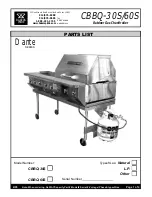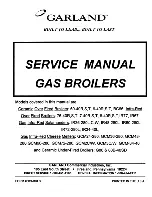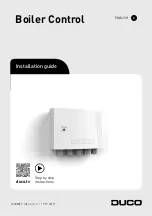
23
105294-05 - 5/15
VII. Venting
B. Design Requirements Unique to Horizontal Twin Pipe Venting Systems (continued)
2. Horizontal Vent and Air Intake Terminal Location - Observe the following limitations on the vent terminal location (also see
Figure 7.11). When locating a concentric terminal, observe the limitations outlined below for “vent terminals”.
• Vent terminal must be at least 1 foot from any door, window, or gravity inlet into the building.
• When Terminal Option A (fittings) are used, maintain the correct clearance and orientation between the intake
and exhaust terminals. If possible, locate vent and combustion air terminals on the same wall to prevent nuisance
shutdowns. If not, boiler may be installed with roof vent terminal and sidewall combustion air terminal (see Section
D). When installed on the same wall, locate exhaust vent terminal at same height or higher than combustion air
intake terminal. Horizontal separation: Recommended: 36”, Minimum: 12”, Maximum: none. Minimum horizontal
separation of 12” is required regardless of vertical separation.
• The bottom of all terminals must be at least 12” above the normal snow line. In no case should they be less than 12”
above grade level.
• The bottom of the vent terminal must be at least 7 feet above a public walkway.
• Do not install the vent terminal directly over windows or doors.
• The bottom of the vent terminal must be at least 3 feet above any forced air inlet located within 10 feet.
• USA Only: A clearance of at least 4 feet horizontally must be maintained between the vent terminal and gas meters,
electric meters, regulators, and relief equipment. Do not install vent terminal over this equipment. In Canada, refer to
B149.1 Installation Code for clearance to meters, regulators and relief equipment.
• Do not locate the vent terminal under decks or similar structures.
• Top of terminal must be at least 24” below ventilated eves, soffits and other overhangs. In no case may the overhang
depth exceed 48”. Where permitted by the authority having jurisdiction and local experience, the terminal may be
located closer to unventilated
soffits. For the minimum vertical separation which depends upon the depth of the soffit,
see Figure 7.11.
• Vent terminal must be at least 6 feet from an inside corner.
• Under certain conditions, water in the flue gas may condense, and possibly freeze, on objects around the vent terminal
including on the structure itself. If these objects are subject to damage by flue gas condensate, they should be moved or
protected.
• Install the vent and air intake terminals on a wall away from the prevailing wind. Reliable operation of this boiler
cannot be guaranteed if these terminals are subjected to winds in excess of 40 mph.
• Air intake terminal must not terminate in areas that might contain combustion air contaminates, such as near
swimming pools. See WARNING on page 15.
Figure 7.6: Horizontal CPVC/PVC Venting, (Vent Options #1 & 2, Terminal Option A)
Summary of Contents for K2
Page 37: ...37 105294 05 5 15 THIS PAGE LEFT BLANK INTENTIONALLY ...
Page 84: ...84 105294 05 5 15 Figure 10 4 Proper Installation of Header Sensor X Wiring continued ...
Page 86: ...86 105294 05 5 15 X Wiring continued ...
Page 87: ...87 105294 05 5 15 Figure 10 6 Internal Wiring Connections Diagram X Wiring continued ...
Page 97: ...97 105294 05 5 15 Lighting and Operating Instructions XI Start Up and Checkout continued ...
Page 106: ...106 105294 05 5 15 ...
Page 107: ...107 105294 05 5 15 ...
















































